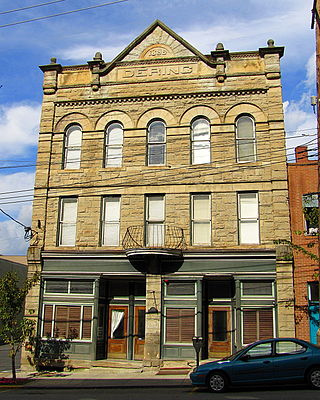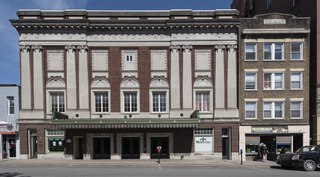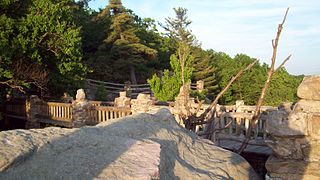
Fletcher Place is a historic district and neighborhood in the city of Indianapolis, Indiana named after Calvin Fletcher, a prominent local banker, farmer and state senator.

The Harner Homestead, is a historic home outside Morgantown, Monongalia County, West Virginia.

The Philippi Historic District (PHD) is national historic district located at Philippi, Barbour County, West Virginia, USA. It encompasses 113 contributing buildings and one contributing structure dating from the mid-19th century through early 20th century. The district includes the commercial, ecclesiastical, and civic core of the town situated along the Tygart Valley River.

Alexander Blount Mahood was a Bluefield, West Virginia-based architect.

Brown Building, also known as the Ream Building, is a historic commercial building located at Morgantown, Monongalia County, West Virginia. It was designed in 1898 by noted Morgantown architect Elmer F. Jacobs. It is a four-story eclectic style brick building. It has a flat roof and projecting cornice. It has a ball finial and parapet centered on the front facade. It features polychromatic brick detailing, accentuated bays and a triad of double-sash windows

Dering Building is a historic commercial building located at Morgantown, Monongalia County, West Virginia. It was designed by noted Morgantown architect Elmer F. Jacobs and built in 1896. It is a three-story Romanesque Revival style brick building. It has a rectangular plan, a flat roof, separate store fronts, and recessed portico entrances. It features a pediment above the flat roof with a rising sun motif and the date of construction inscribed in the center.
Elmer F. Jacobs was a Morgantown, West Virginia-based architect.

Metropolitan Theatre is a historic theater building located at Morgantown, Monongalia County, West Virginia. It opened July 24, 1924, two-and-a-half years after construction began, and consists of a single floor auditorium with balcony. The building measures 72 feet by 143 feet, and has two storefronts on the ground floor and a pool room in the basement. The front facade features fluted concrete Ionic order pilasters with egg-and-dart detail in the Classical Revival style. The theater continues to provide a home for the city's best live entertainment.

Cooper's Rock State Forest Superintendent's House and Garage is a historic home and garage located at Cooper's Rock State Forest near Morgantown, Monongalia County, West Virginia. The house was built between 1938 and 1940, and is a two-story, symmetrical log building, measuring 35 feet by 43 feet. Also on the property is a contributing garage also of log construction. Both buildings were built by the Civilian Conservation Corps, CCC camp number 3527, Camp Rhododendron.

Camp Rhododendron, also known as Camp Rhododendron Recreational Historic District, is a historic Civilian Conservation Corps camp and national historic district located at Cooper's Rock State Forest near Morgantown, Monongalia County, West Virginia. The district includes seven contributing buildings, one contributing structure, and two contributing objects. It was constructed between 1936 and 1942, and includes a pumphouse, Robert Fechner Monument, information booth, three pavilions, an overlook / walkway, concession stand, fire warning sign, and trail chalet. They are built of hewn logs and sandstone and representative of the Depression-era Rustic style of architecture. Located nearby is the Cooper's Rock State Forest Superintendent's House and Garage, also built by the CCC.

Chancery Hill Historic District is a national historic district located at Morgantown, Monongalia County, West Virginia. The district originally included 109 contributing buildings and 1 contributing site, Oak Grove Cemetery. A boundary increase in 2001, added the already listed Alexander Wade House to the district. The district encompasses a residential area developed in the early-20th century on property that was once the farm of U.S. Senator Waitman T. Willey. It includes examples of popular architectural styles from that period including Queen Anne, American Foursquare, Colonial Revival, and Bungalow.

The Downtown Morgantown Historic District is a federally designated historic district in Morgantown, Monongalia County, West Virginia. The district, encompassing approximately 75 acres, has 122 contributing buildings and 2 contributing sites including commercial and public buildings, residences, and churches. The district has been listed on the National Register of Historic Places since May 2, 1996. Ten of the contributing buildings are listed separately on the National Register of Historic Places. Significant structures located within the historic district are the Monongalia County Courthouse, the Metropolitan Theater, and the Old Morgantown Post Office.

Greenmont Historic District is a national historic district located at Morgantown, Monongalia County, West Virginia. The district includes 409 contributing buildings, 4 contributing structures, and 2 contributing objects in a primarily residential area of the Greenmount neighborhood of Morgantown. Most of the dwellings were built between 1901 and 1925 and are of frame construction with brick or wood facades, one- to 2+1⁄2 stories high with gable fronts. Notable buildings include the Reformation Orthodox Presbyterian Church. Also in the district are the separately listed Kern's Fort, and Hackney House.

Morgantown Wharf and Warehouse Historic District is a national historic district located at Morgantown, Monongalia County, West Virginia.

Union Historic District is a national historic district located at Union, Monroe County, West Virginia. The district includes 174 contributing buildings, 2 contributing sites, 7 contributing structures, and 1 contributing object in the Union and surrounding areas.

Kingwood Historic District is a national historic district located at Kingwood, Preston County, West Virginia. The district encompasses 103 contributing buildings in the central business district and surrounding residential areas of Kingwood. Most of the buildings are two story, frame and masonry buildings. Notable buildings include the Preston County Courthouse (1934), Kingwood National Bank Building (1908), C.M. Bishop House (1872), Preston Academy (1842), IOOF Lodge, Bank of Kingwood (1900), Bishop Block (1877), Presbyterian Church (1878), Methodist Church (1879), Wilson Building (1930), and Loar's Service Station (1927). Located in the district and listed separately is the James Clark McGrew House.

Fayetteville Historic District is a national historic district located at Fayetteville, Fayette County, West Virginia. The district encompasses 126 contributing buildings, 4 contributing sites, and 3 contributing structures. It includes the central business district and surrounding residential areas of Fayetteville. Notable buildings include Jack's Garage (1934), Theatre Building (1935), Fayette County Jail (1907), McClung House (1850), Old Methodist Church, Old Post Office (1920), Bank of Fayette-Town Hall (1921), U.S. Post Office (1938), and the War Memorial Building (1949). Also in the district is the site of Fort Toland, site of Fort Scammon and the Old Fayetteville Cemetery. The district includes the separately listed Fayette County Courthouse, E. B. Hawkins House, and Altamont Hotel.

The Morgantown Historic District, also known as the Old Main Street Historic District, is a national historic district that is located in Caernarvon Township, Berks County, Pennsylvania.

Morgantown Historic District is a national historic district located near Marshall, Fauquier County, Virginia. It encompasses 7 contributing buildings and 2 contributing sites in the Reconstruction-era African-American rural village of Morgantown. The district contains four dwellings, the Mount Nebo Baptist Church (1902), an abandoned Morgantown School, a meat house, the ruins of an outbuilding, and a cemetery.

The Main Street Banking Historic District is a national historic district located in downtown Richmond, Virginia. The district encompasses 19 contributing buildings located south of the Virginia State Capitol and west of the Shockoe Slip Historic District. It is the location of a number of buildings built for or occupied by banking institutions. The district includes representative examples of the Late Victorian and International Style architecture built between about 1865 and 1965. Notable buildings include the Virginia Employment Commission Building (1960), the 700 Building (1964), the Ross Building (1964), the Fidelity Building (1965). Located in the district is the separately listed First National Bank Building.






















